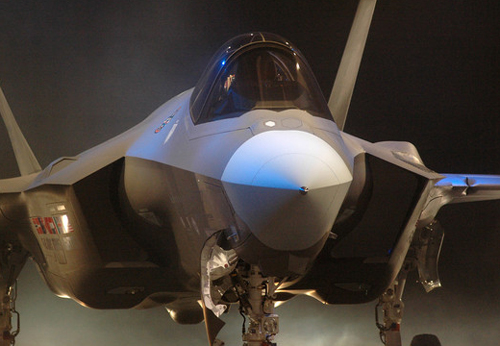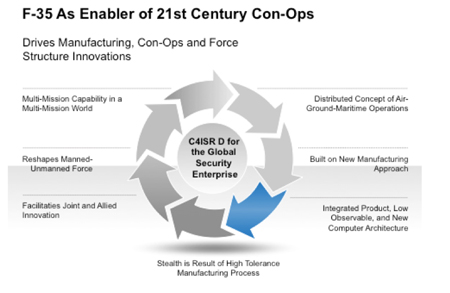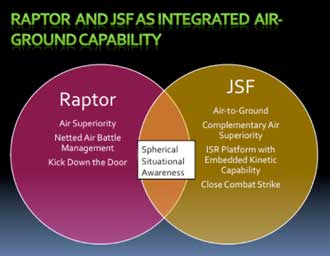The USAF F35A Lighting
Credit: www.defencetalk.com
(click on picture to access military gallery)
A “Flying Combat System” With a Maturing Approach to C4ISR
The F-35 is a “flying combat system” that will have an immediate impact on air capability with its initial deployment. The first squadron(s) of the aircraft will, for the first time, bring a C4ISR platform into the air combat domain. With this platform, the F-35 will become a major contributor to air-surface operations.
A key 5th generation aircraft, the F-35 is built around a new approach to C4ISR. With the computational and fused sensor capabilities of the aircraft, the air warrior is now elevated to a team player. He is able to collaborate with his teammates, share real time knowledge, and have grid situational awareness.
This capability is largely machine based and provides a common knowledge currency for use by the Blue Team. The onboard machines provide real time C4ISR that is merged onboard and then shared with the combat team on the ground. This gives the soldier a broader combat picture and an ability to make faster, more accurate decisions in a rapidly changing combat environment.
The F-22 showed the early blossoming of this capability but the F-35, with its more advanced integrated sensors, will bring this leveraged team approach into full bloom. To guarantee its full impact, the aircraft and its systems needs to be an integral part of the knowledge grid. For this integration to occur, the warrior must be a full member in virtual and collaborative task-oriented teams. The F-35 is a key enabler of such activities and part of a 21st century concept of air operations .
Credit: SLD, 2009
A Force Multiplier for Legacy Air Assets
A core challenge to the introduction of the F-35 will not simply be to work with its own species, but to work with legacy aircraft, whether U.S. or allied. The new fighter clearly can force multiply legacy assets.
How will the F-35 work with legacy air assets and in an air-to-surface environment? The F-35 will make legacy aircraft around it more capable through its ability to process data in the air. Once processed, the data will be converted into a Link 16 message and transferred to legacy aircraft or surface teams. At present, surface assets suffer from a significant bandwidth problem. The F-35’s processors can lend a hand by processing data and sending appropriate results to the ground forces.
The F-35 will also have a significant impact in organizing air combat operations. The more recent aircraft, such as Eurofighter and upgraded F-15s and F-16s, are most easily organized for operations by the F-35. The older aircraft can also be organized more efficiently by the F-35’s processing and stealth capacities, as well as the ability to share this data in real-time. These efforts combined will shape more effective collaborative decision-making.
This capability will be rolled out as F-35 squadrons are added to the fleet. Each new squadron will allow the F-35 to become a more significant player in shaping the operations of air and surface forces. A way to think about the insertion of F-35s in the fleet is to conceptualize a sliding scale of capability. As F-35s supplant legacy aircraft, the fleet’s capability grows. But most importantly, legacy fleets do not need to be completely replaced to see an effect; instead, the F-35 will provide an immediate, significant enhancement of overall fleet capabilities.
In short, the F-35 will enable today’s fleet to work more effectively on the day the aircraft is introduced in operational squadrons. Air operations and air-surface integration will then be transformed as greater numbers are deployed in the U.S. Air Force, USMC, USN, and allied forces. With a significant expansion of the interoperability of U.S. and coalition forces , overall capability for the U.S. and its allies will be enhanced. The F-35 is a force multiplier on the first day it will be deployed.
In this regard, it is important that the con-ops of collaborative operations are fully supported. The links need to be paid for; protocols for information sharing with allies need to be worked out; and cybersecurity on the fly needs to be ensured. Simply buying the F-35 is not enough; a significant effort and investment is also crucial so that U.S. and allied forces get the best value out of the aircraft.
———-
*** Posted on March 22nd, 2010





